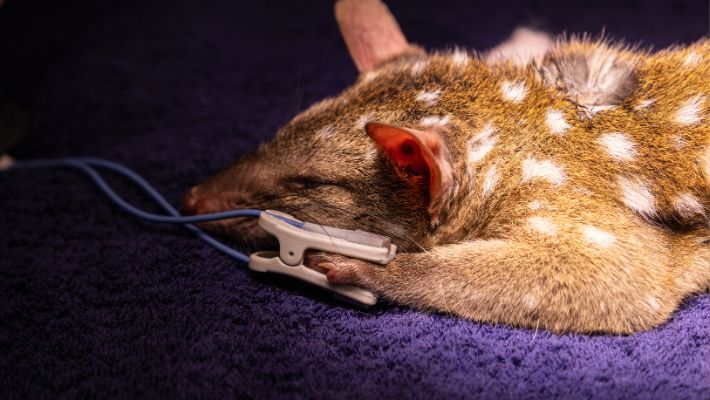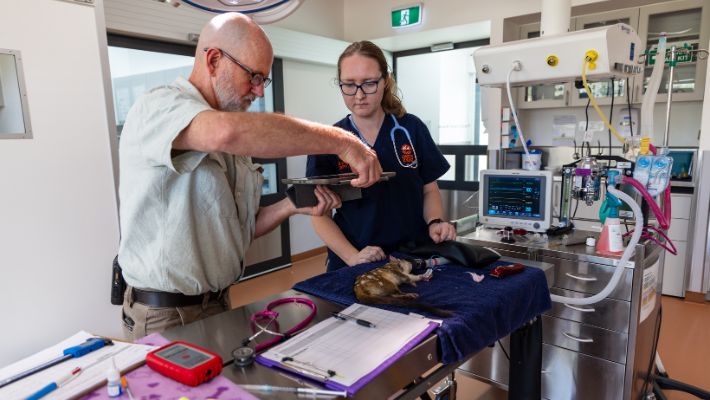Posted on 13th November 2024 by Media Relations
A record number of Chuditch have received the vets’ tick of approval after another successful breeding season at Taronga Western Plains Zoo on Wiradjuri Country.
The Zoo has wrapped up its most productive breeding season yet for the endangered marsupial, with a record 35 joeys born to seven breeding pairs within the 110-hectare Taronga Sanctuary.
Senior Veterinarian Dr Alisa Wallace oversaw the five-day marathon health check, which saw 37 Chuditch processed through the Wildlife Hospital for physical examinations, dental checks and blood work, all under anaesthetic.
“That’s the largest group of Chuditch that we’ve done health checks on, and the biggest year that we’ve had in our breeding program so far,” Dr Wallace said.
“The mums have done a brilliant job and produced perfect little joeys that are thriving.”
Preparations are now underway to release 28 of the Chuditch to safe rewilding sites around Australia, to bolster wild populations and enhance their genetic diversity.
The rest will remain at Taronga Western Plains Zoo for the next breeding season and future releases.

Also known as the Western Quoll, the Chuditch was once found across 70% of mainland Australia but has been reduced to just 5% of its former range. The species was extinct in NSW until earlier this year, when 16 Taronga-bred individuals were released into Sturt NP, marking the species’ return to the state after a century-long absence.
Taronga-bred Chuditch have also been released in South Australia and Western Australia, with more releases planned.
The health checks are part of Taronga’s pre-release strategy to ensure that animals are fit for release and also ensure the health of individuals being retained for the next breeding season.
“We want to make sure we give them the best chance when they go out into the wild, checking that they’ve got all the tools they need to catch their own food, that they’re in good body condition, and they don’t have any diseases or parasites that they could transmit to the wild population,” Dr Wallace said.
“The Chuditch program is a really exciting project, releasing them back into the wild in places where they’ve been extinct for over 100 years. It’s a really great feeling to be part of that re-wilding.”
Taronga’s Chuditch conservation breeding program was established in 2022, thanks to a generous philanthropic donation from The Kinghorn Foundation.
The animals in the Taronga Sanctuary are monitored remotely using camera traps to minimise human interaction and keep them as wild as possible.
Senior Conservation Keeper Nic Atchison said the hands-off nature of Taronga’s program made it unique.
“We don’t manage them very intensively, which would be typical for this species in other institutions,” he said.
“A lot of the monitoring that goes on, firstly with the pairing to make sure the animals are compatible, that they’re mating and breeding and then we do pouch checks to make sure there are young in the pouch. From there it’s pretty much video monitoring to make sure the animals are all progressing well.
“When the older ones are nearing the age of independence, that’s when we start to bring them in to do the health checks and make sure they’re in really good condition.”

The Chuditch is one of four species of quoll in Australia, and WA’s largest endemic carnivore. As a top-level predator, they play an important role in the Australian ecosystem.
“Chuditch are a really important species in the Australian ecosystem,” Mr Atchison said.
“The reintroduction of carnivores into ecosystems tends to have cascading effects and create more of a balance which has positive effects for animals much further down the food chain, so it’s going to be very interesting to see the longer-term effects of reintroducing quolls back into the landscape.
“I feel really honoured to be working on this program – I think working on a conservation program is one of the great things you can do in any modern zoo.
“Zoos have multiple roles of educating the public and raising awareness of any conservation concerns around different animals, but to breed animals and put them into the wild is just such a fantastic program to be working on, and something I’m really pleased to be a part of.”
About Taronga’s Chuditch conservation breeding program
Taronga’s Chuditch conservation breeding program commenced in 2022 in the Taronga Sanctuary in Dubbo, thanks to a generous philanthropic donation from The Kinghorn Foundation.
Founders were selected in collaboration with the Western Australian Department of Biodiversity, Conservation and Attractions (DBCA), and the South Australian Department for Environment and Water (DEW), with new founders added in 2023.
To date Taronga has released 46 Chuditch back to re-wilding sites, including South Australia’s Vulkathunha-Gammon Ranges National Park, Australian Wildlife Conservancy’s Mount Gibson Sanctuary on Badimia and Widi Country in the West Australian Wheatbelt, and Sturt National Park through the Wild Deserts program.
Taronga is a not-for-profit organisation. This means whether you visit, stay overnight, donate, become a Zoo Friend, book an unforgettable encounter, or buy a gift for a loved one, every dollar you spend has the power to protect and save wildlife.